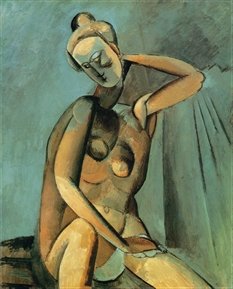Pablo Picasso, Nude, 1909.
Oil on canvas, 100 x 81.2 cm.
The State Hermitage Museum,
St. Petersburg.
Scholars now cautiously speak not only of a return to the concrete but also of a dramatisation of the surrounding space (Daix) in such works as Green Pan and Black Bottle and Pitcher and Bowls. We are shattered by the dramatic exaltation of Green Pan and Black Bottle, an effect one would rather expect from a scene of passion and martyrdom. Forty years before Abstract Expressionism, the pictorial power of the painting’s background predicted (and perhaps transcended) that later movement, with its “sorrow of final days”, so sharply felt by the critics of Picasso. Such extraordinary dramatic power must have been accompanied by no less extraordinary psychological conditions. From Fernande Olivier’s memoirs we know how deeply Picasso was shocked by the suicide of his Bateau-Lavoir neighbour, the German painter Wiegels, on 1 June 1908. While stylistically belonging to the summer works of that period, the Green Pan and Black Bottle’s funereal black-and-red tonal chord may reflect Picasso’s as yet unalleviated anguish. Yet in the still life Pitcher and Bowls, painted soon after, controlled thought dominates over the drama of emotions. This fact is manifested in several ways: in the incontestable logic of the spatial plastic structure, as opposed to illusory perspective; in the monumental grouping of sculptured forms concentrated in an ascending spiral around a common axis; in the overall rhythm of curves and ovals; in the vibrant, yet solid, equilibrium of the entire tectonic structure; in the painting’s image; in the contained energy of the brushwork; and, finally, in the desire to achieve perfection in completeness.
